

4.2k
0
基于 Nginx 的开源 WAF,让 Web 服务自带安全能力

基于 Nginx 的开源 WAF,让 Web 服务自带安全能力
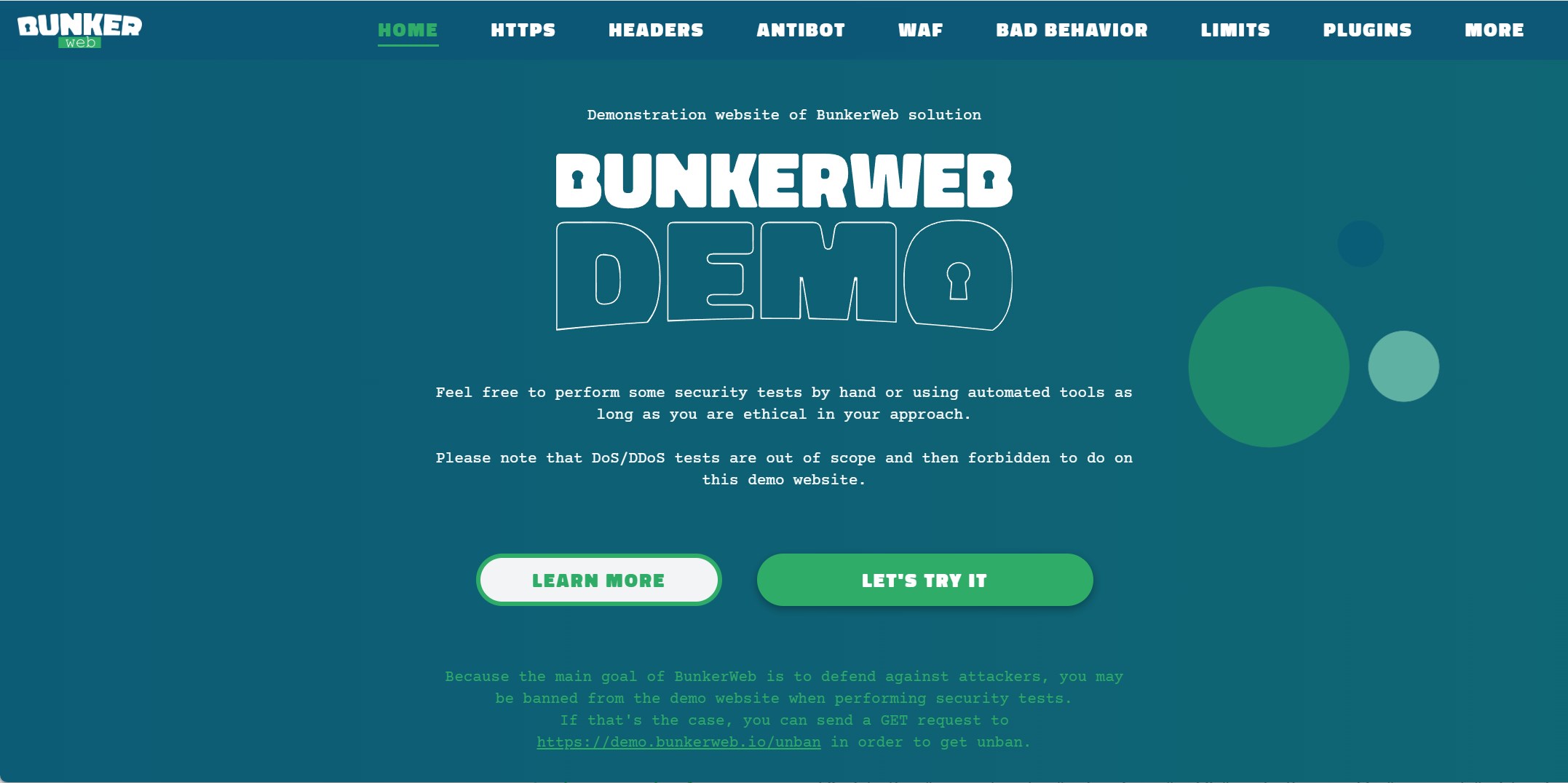



🌐 Website
|
🤝 Panel
|
📓 Documentation
|
👨💻 Demo
|
🛡️ Examples
|
💬 Chat
|
📝 Forum
⚙️ Configurator
|
🗺️ Threatmap
|
🔎 Feedbacks
🛡️ Make security by default great again !

BunkerWeb is a next-generation and open-source Web Application Firewall (WAF).
Being a full-featured web server (based on NGINX under the hood), it will protect your web services to make them "secure by default". BunkerWeb integrates seamlessly into your existing environments (Linux, Docker, Swarm, Kubernetes, …) and is fully configurable (don't panic, there is an awesome web UI if you don't like the CLI) to meet your own use-cases . In other words, cybersecurity is no more a hassle.
BunkerWeb contains primary security features as part of the core but can be easily extended with additional ones thanks to a plugin system.
A non-exhaustive list of security features :
Learn more about the core security features in the security tuning section of the documentation.
A demo website protected with BunkerWeb is available at demo.bunkerweb.io. Feel free to visit it and perform some security tests.
Don't want to self-host and manage your own BunkerWeb instance(s) ? You might be interested into BunkerWeb Cloud, our fully managed SaaS offer for BunkerWeb.
Try our BunkerWeb Cloud beta offer for free and get access to :
You will find more information about BunkerWeb Cloud in the FAQ page of the BunkerWeb panel.
When using BunkerWeb you have the choice of the version you want to use : open-source or PRO.
Whether it's enhanced security, an enriched user experience, or technical supervision, the BunkerWeb PRO version will allow you to fully benefit from BunkerWeb and respond to your professional needs.
Be it in the documentation or the user interface, the PRO features are annotated with a crown to distinguish them from those integrated into the open-source version.
You can upgrade from the open-source version to the PRO one easily and at any time you want. The process is pretty straightforward :
Do not hesitate to visit the BunkerWeb panel or contact us if you have any question regarding the PRO version.
Get the most of BunkerWeb by getting professional services directly from the maintainers of the project. From technical support to tailored consulting and development, we are here to assist you in the security of your web services.
You will find more information by visiting the BunkerWeb Panel, our dedicated platform for professional services.
Don't hesitate to contact us if you have any question, we will be more than happy to respond to your needs.
Official websites, tools and resources about BunkerWeb :
Community and social networks :

You will find more information about the key concepts of BunkerWeb in the documentation.
The first concept is the integration of BunkerWeb into the target environment. We prefer to use the word "integration" instead of "installation" because one of the goals of BunkerWeb is to integrate seamlessly into existing environments.
The following integrations are officially supported :
Once BunkerWeb is integrated into your environment, you will need to configure it to serve and protect your web applications.
The configuration of BunkerWeb is done by using what we call the "settings" or "variables". Each setting is identified by a name such as AUTO_LETS_ENCRYPT or USE_ANTIBOT. You can assign values to the settings to configure BunkerWeb.
Here is a dummy example of a BunkerWeb configuration :
1SERVER_NAME=www.example.com
2AUTO_LETS_ENCRYPT=yes
3USE_ANTIBOT=captcha
4REFERRER_POLICY=no-referrer
5USE_MODSECURITY=no
6USE_GZIP=yes
7USE_BROTLI=no
You will find an easy to use settings generator at config.bunkerweb.io.
The multisite mode is a crucial concept to understand when using BunkerWeb. Because the goal is to protect web applications, we intrinsically inherit the concept of "virtual host" or "vhost" (more info here) which makes it possible to serve multiple web applications from a single (or a cluster of) instance.
By default, the multisite mode of BunkerWeb is disabled which means that only one web application will be served and all the settings will be applied to it. The typical use case is when you have a single application to protect : you don't have to worry about the multisite and the default behavior should be the right one for you.
When multisite mode is enabled, BunkerWeb will serve and protect multiple web applications. Each web application is identified by a unique server name and have its own set of settings. The typical use case is when you have multiple applications to protect and you want to use a single (or a cluster depending of the integration) instance of BunkerWeb.
Because meeting all the use cases only using the settings is not an option (even with external plugins), you can use custom configurations to solve your specific challenges.
Under the hood, BunkerWeb uses the notorious NGINX web server, that's why you can leverage its configuration system for your specific needs. Custom NGINX configurations can be included in different contexts like HTTP or server (all servers and/or specific server block).
Another core component of BunkerWeb is the ModSecurity Web Application Firewall : you can also use custom configurations to fix some false positives or add custom rules for example.

State of the current configuration of BunkerWeb is stored in a backend database which contains the following data :
The following backend database are supported : SQLite, MariaDB, MySQL and PostgreSQL
To make things automagically work together, a dedicated service called the scheduler is in charge of :
In other words, the scheduler is the brain of BunkerWeb.

BunkerWeb Cloud is the easiest way to get started with BunkerWeb. It offers you a fully managed BunkerWeb service with no hassle. Think of a like a BunkerWeb-as-a-Service !
You will find more information about BunkerWeb Cloud beta here and you can apply for free in the BunkerWeb panel.

We provide ready to use prebuilt images for x64, x86, armv7 and arm64 platforms on Docker Hub.
Docker integration key concepts are :
You will find more information in the Docker integration section of the documentation.

The downside of using environment variables is that the container needs to be recreated each time there is an update which is not very convenient. To counter that issue, you can use another image called autoconf which will listen for Docker events and automatically reconfigure BunkerWeb in real-time without recreating the container.
Instead of defining environment variables for the BunkerWeb container, you simply add labels to your web applications containers and the autoconf will "automagically" take care of the rest.
You will find more information in the Docker autoconf section of the documentation.

To automatically configure BunkerWeb instances, a special service, called autoconf will listen for Docker Swarm events like service creation or deletion and automatically configure the BunkerWeb instances in real-time without downtime.
Like the Docker autoconf integration, configuration for web services is defined using labels starting with the special bunkerweb. prefix.
You will find more information in the Swarm section of the documentation.

The autoconf acts as an Ingress controller and will configure the BunkerWeb instances according to the Ingress resources. It also monitors other Kubernetes objects like ConfigMap for custom configurations.
You will find more information in the Kubernetes section of the documentation.

List of supported Linux distros :
You will find more information in the Linux section of the documentation.

BunkerWeb is referenced in the Azure Marketplace and a ARM template is available in the misc folder.
You will find more information in the Microsoft Azure section of the documentation.
Once you have setup BunkerWeb with the integration of your choice, you can follow the quickstart guide that will cover the following common use cases :
BunkerWeb offers many security features that you can configure with settings. Even if the default values of settings ensure a minimal "security by default", we strongly recommend you to tune them. By doing so you will be able to ensure a security level of your choice but also manage false positives.
You will find more information in the security tuning section of the documentation.
To help you tuning BunkerWeb we have made an easy to use settings generator tool available at config.bunkerweb.io.
As a general rule when multisite mode is enabled, if you want to apply settings with multisite context to a specific server you will need to add the primary (first) server name as a prefix like www.example.com_USE_ANTIBOT=captcha or myapp.example.com_USE_GZIP=yes for example.
When settings are considered as "multiple", it means that you can have multiple groups of settings for the same feature by adding numbers as suffix like REVERSE_PROXY_URL_1=/subdir, REVERSE_PROXY_HOST_1=http://myhost1, REVERSE_PROXY_URL_2=/anotherdir, REVERSE_PROXY_HOST_2=http://myhost2, ... for example.
Check the settings section of the documentation to get the full list.
The "Web UI" is a web application that helps you manage your BunkerWeb instance using a user-friendly interface instead of the command-line one.
You will find more information in the Web UI section of the documentation.
BunkerWeb comes with a plugin system to make it possible to easily add new features. Once a plugin is installed, you can manage it using additional settings defined by the plugin.
Here is the list of "official" plugins that we maintain (see the bunkerweb-plugins repository for more information) :
| Name | Version | Description | Link |
|---|---|---|---|
| ClamAV | 1.6 | Automatically scans uploaded files with the ClamAV antivirus engine and denies the request when a file is detected as malicious. | bunkerweb-plugins/clamav |
| Coraza | 1.6 | Inspect requests using a the Coraza WAF (alternative of ModSecurity). | bunkerweb-plugins/coraza |
| CrowdSec | 1.6 | CrowdSec bouncer for BunkerWeb. | bunkerweb-plugins/crowdsec |
| Discord | 1.6 | Send security notifications to a Discord channel using a Webhook. | bunkerweb-plugins/discord |
| Slack | 1.6 | Send security notifications to a Slack channel using a Webhook. | bunkerweb-plugins/slack |
| VirusTotal | 1.6 | Automatically scans uploaded files with the VirusTotal API and denies the request when a file is detected as malicious. | bunkerweb-plugins/virustotal |
| WebHook | 1.6 | Send security notifications to a custom HTTP endpoint using a Webhook. | bunkerweb-plugins/slack |
You will find more information in the plugins section of the documentation.
Get technical support directly from the BunkerWeb maintainers. You will find more information by visiting the BunkerWeb Panel, our dedicated platform for professional services.
Don't hesitate to contact us if you have any question, we will be more than happy to respond to your needs.
To get free community support you can use the following media :
Please don't use GitHub issues to ask for help, use it only for bug reports and feature requests.
This project is licensed under the terms of the GNU Affero General Public License (AGPL) version 3.
If you would like to contribute to the plugins you can read the contributing guidelines to get started.
We take security bugs as serious issues and encourage responsible disclosure, see our security policy for more information.

长亭科技
8.3k
8
一款足够简单、足够好用、足够强的免费 WAF。基于业界领先的语义引擎检测技术,作为反向代理接入,保护你的网站不受黑客攻击。
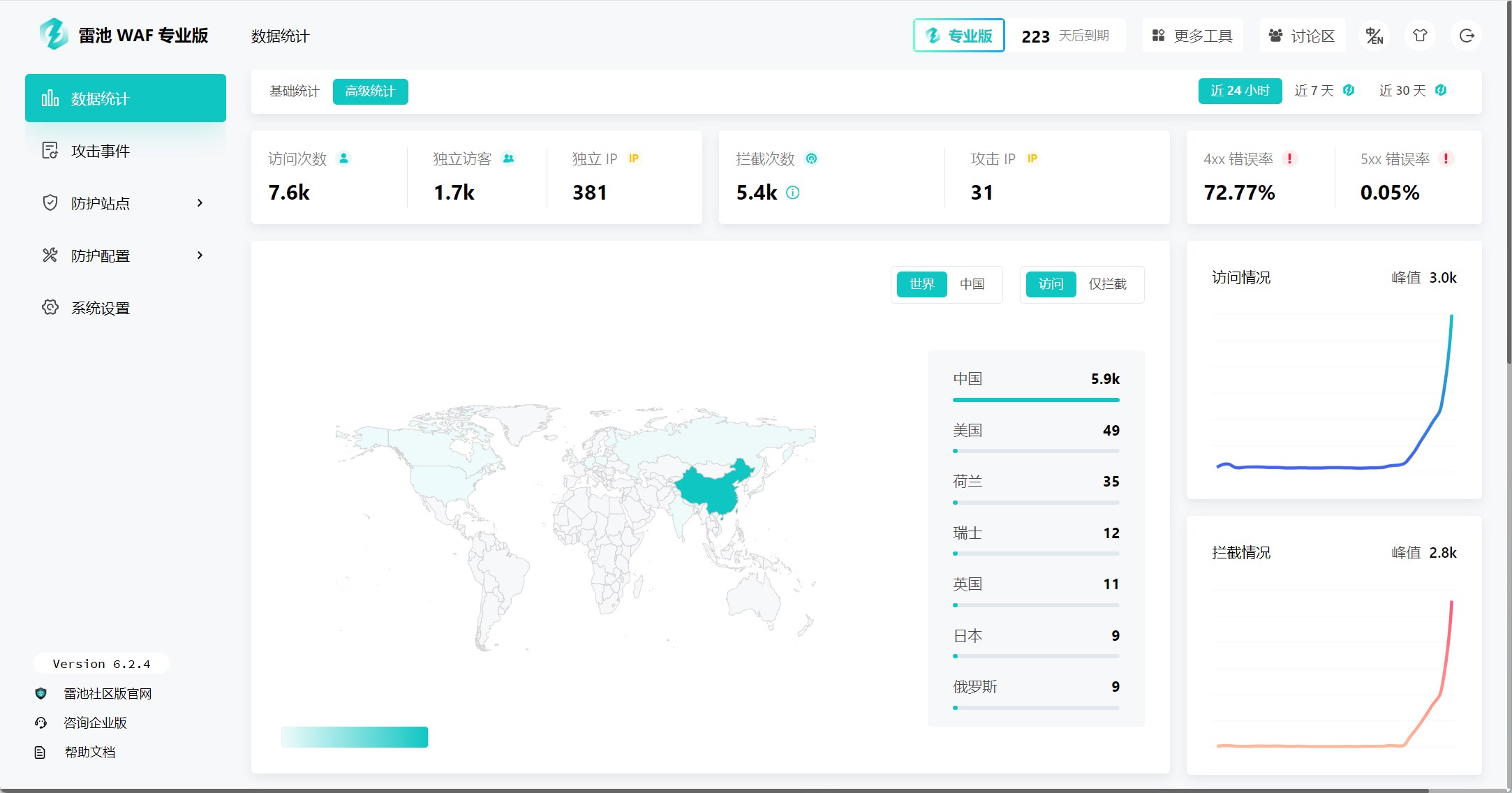
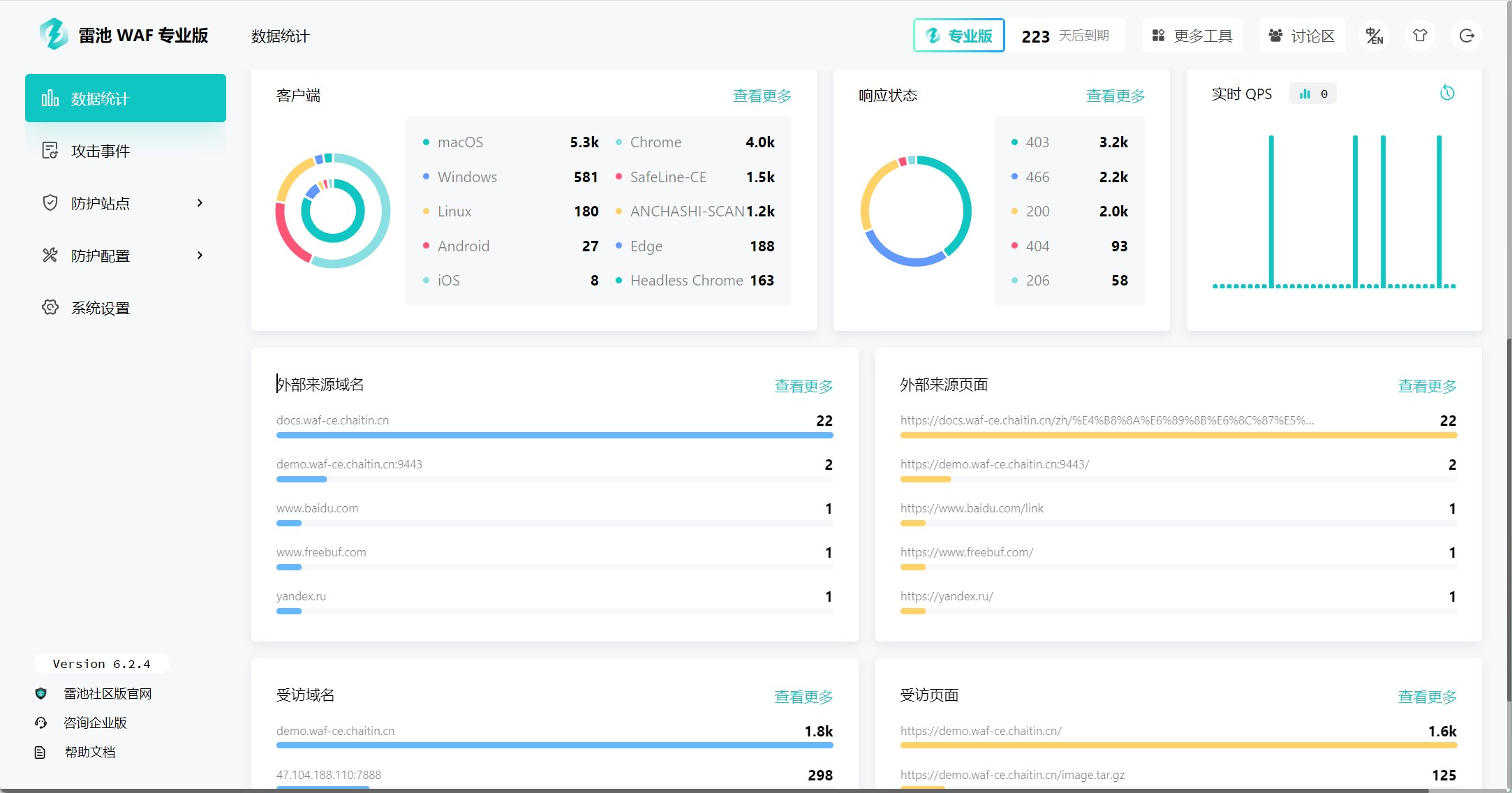

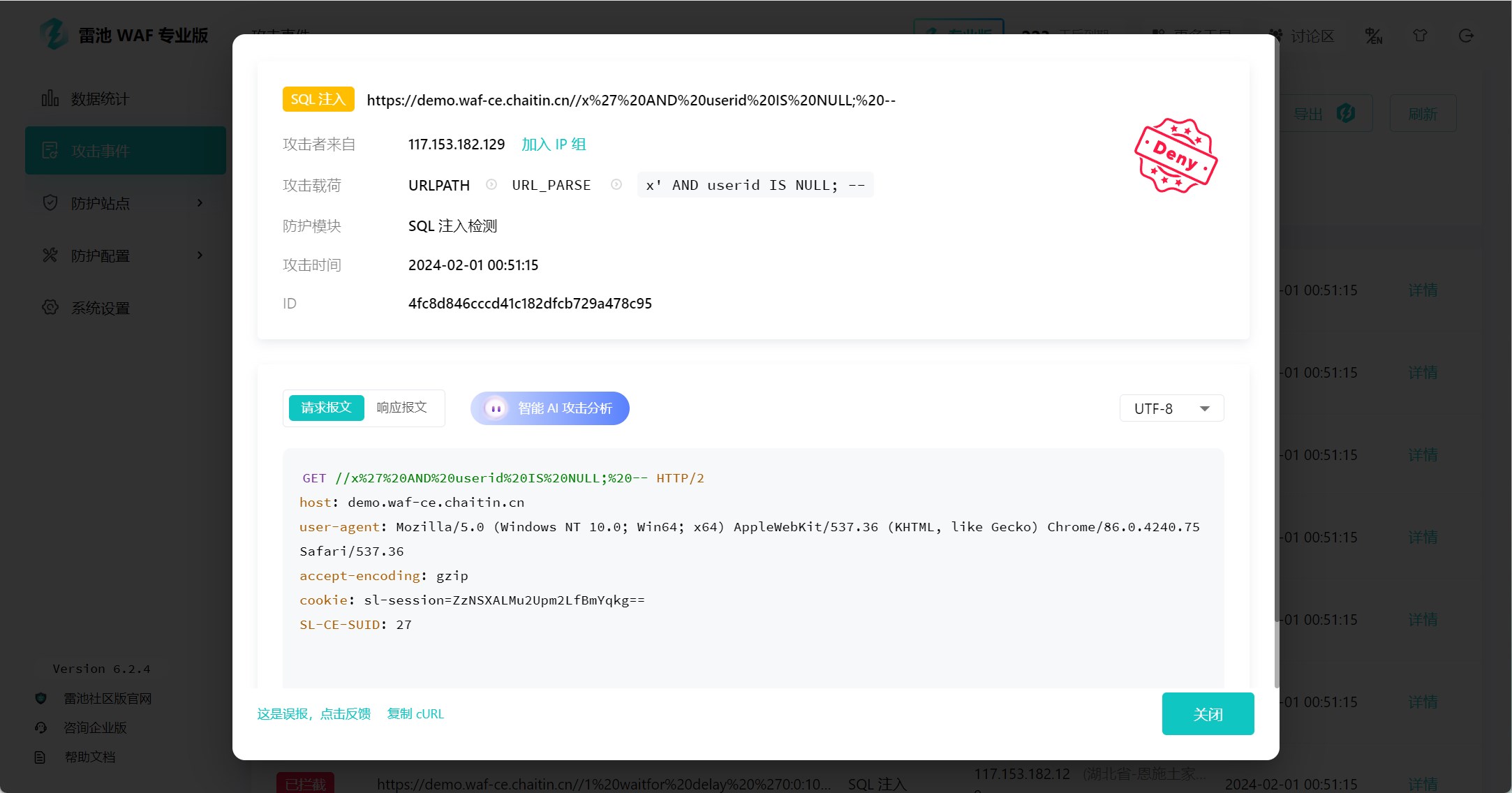
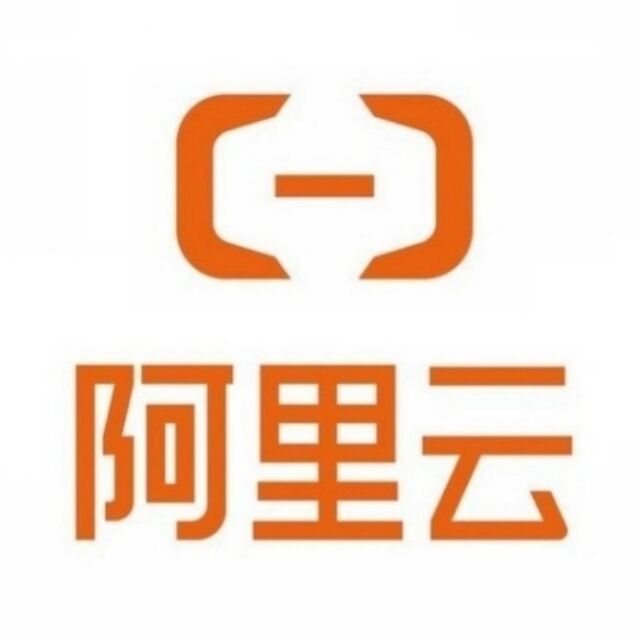
阿里云
4.2k
1
阿里云Web应用防火墙,对网站或者APP的业务流量进行恶意特征识别及防护,将正常、安全的流量回源到服务器。避免网站服务器被恶意入侵,保障业务的核心数据安全,解决因恶意攻击导致的服务器性能异常问题。


